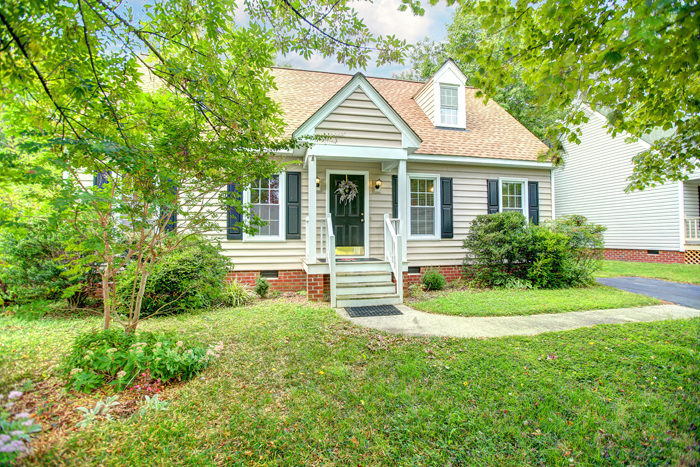Richmond, virginia
View of Broad Street at Richmond City Hall, 24th floor.
Overview
Richmond is the capital of the Commonwealth of Virginia. It is the center of the Richmond Metropolitan Statistical Area (MSA) and the Greater Richmond Region. Located at the fall line of the James River, Richmond is surrounded by Henrico and Chesterfield counties, and the major suburbs include Midlothian to the southwest, Glen Allen to the north and west, Short Pump to the west and Mechanicsville to the northeast. Richmond is located in the middle south section of the East coast. The city has convenient accesses to Washington D.C. and several nearby cities. Such location makes Richmond an important economical and political center. Starting 2007, the greater Richmond area is the third-best city for business according to MarketWatch, ranking behind only the Minneapolis and Denver areas and just above Boston. The area is home to six Fortune 500 companies: electric utility Dominion Resources; CarMax; Owens & Minor; Genworth Financial; WestRock Company; McKesson Medical-Surgical, Markel Corporation, and Altria Group.
Richmond CITY AWARDS:
Richmond named the nation's fourth hottest housing market - Zillow, 2016
The Best Big Cities to Live and Work, Richmond, Va. is ranked number 6 - CreditDonkey, 2014
Richmond is one of the 10 Up And Coming Cities for Entrepreneurs - Forbes, 2013
The 10 best cities for foodies - Richmond, Va. is ranked number 9 - American City&County, 2016
Richmond named "Top 20 Cities to start a Business" - CNBC, 2016
Richmond named "Tree City USA" for 25th Consecutive year - Arbor Day Foundation
Richmond named third internationally in "Best Places to Travel"- Travel & Leisure, 2016
Find the best places to Trick or Treat – Hanover Avenue in Richmond, VA is rated in the top 10 in the USA. - The Wall Street Journal, 2016
Transportation and Tourism
Shockoe Bottom highway and train intersections
Amtrack passenger train passing through Henrico.
Richmond is at the intersection of several highways. The intersection includes the major north-south bound Interstate 95 and the east-west bound Interstate 64, and supported by Interstate 295 and Virginia State Route 288. Several other cities falls within the two-hour driving range of Richmond, including Williamsburg (44 miles/71 km) and Virginia Beach (100 miles/161 km) in the east, Charlottesville in the west (66 miles/106 km), and Washington, D.C. in the north (98 miles/158 km). Given such location, living in Richmond provides convenient connections for business and leisure purposes, while avoiding the various hassles and financial costs from big city life.
The two-hour circle also includes several tourist and shopping hotspots. The list includes Virginia Beach, Shenandoah National Park, Kings Dominion, Busch Gardens, Ikea in Woodbridge, Williamsburg Premium Outlets, Leesburg Corner Premium Outlets, and Potomac Mills Mall.
Richmond has several train stations and its own International Airport. Also, the major regional airport Ronald Reagan Washington National Airport (DCA) is about 100 miles/161 km to the north. There are plenty of options for longer travel.
Short Pump Town Center, an open-air shopping center.
History
Richmond has several hundred years of history, founded in 1737, It became the capital of the Colony and Dominion of Virginia in 1780. In 1775, Patrick Henry delivered his famous "Give me Liberty or Give me Death" speech in St. John's Church in Richmond, setting the course for American revolution and independence. Richmond also served as the capital of the Confederate States of America for almost the whole of the American Civil War. Today, the city provides a unique comprehensive perspective for the war with numerous monuments, memorials, and museums. Richmond continues to be a major railroad crossroads and industry center after the war, being one of the first American cities to have an extensive network of electric streetcars. In the 20the century, downtown Richmond continue to grow steady in population, building numbers and diverse businesses. A multimillion-dollar flood wall was completed in 1995, in order to protect low-lying areas of city from the oft-rising waters of the James River, resulting in a boom of entertainment, dining and nightlife businesses in the Shockoe Bottom area.
Demographic
Richmond racial census dot map, 2010. Source: https://demographics.virginia.edu/DotMap/index.html
As of the 2010 United States census, the population in Richmond city was 204,214; in 2016, the population was estimated to be 223,170. The Richmond Metropolitan Area has a population of 1,260,029, as the third-most populous metro in the state and one of the fastest growing metro areas in the country. Of the 204,214 people residing in the city, 50.6% were Black or African American, 40.8% White, 5.0% Asian, and 6.3% were Hispanic or Latino.
Average Incomes and Housing Expenses
House interior in Richmond. Source: http://greatrichmond.com/listings.asp
Richmond has been recommended as one of the best cities to work and live (CreditDonkey, 2014). This is a result of the excellent educational resources and living environments in Richmond. According to the Center for Community and Economic Research in 2016, the housing costs in Richmond is 27%, which is 13 percent than the average for the United States. The median family income was $65,289. The Per Capita income was $27,887. There's a big variety of housing types and styles in downtown Richmond, its suburbs and rural areas, and although the average sale price is $253,449 — above the U.S. average — homes are still less expensive than in nearby Washington, D.C. Richmond is named the nation's fourth hottest housing market in 2016 by Zillow. The area’s housing market is optimistic.
House Styles
Image provider: Greateichmond.com
Located in the middle section of east coast, the house styles in Richmond are diverse and transitional. They create a mixed landscape, having influences from the northern Colonial styles and the southern farm/ranch styles, and dotted by the modernist and contemporary styles. The main house styles in Richmond include:
Cape Cod
Cape Cods have been built since the 1600s. They were inspired by Britain's cottages, but built with steeper roofs and larger chimneys to withstand cold winters. Windows flanking the front door, dormer windows up top and cedar shingles are also typical of the style. Most of today's Cape Cods are built after World War II; they are the popular style for modestly priced housing developments.
Colonial
Colonial styles focuses on strict symmetry. It is typically a box shape and is adorned with windows, which are typically five across and shutters. The style also features a paneled front door below a decorative crown, which is usually framed by simple, sometimes flattened, columns.
The Federal Colonial style is modeled after Roman classicism and the basic Colonial style, Federal Colonial style differs with the addition of wings off to each side of the original box shape and tends to have more decorative embellishments than other Colonial styles. Federal style homes are most often made of brick. The front facade denotes the owner’s wealth with its ornamentation, tall columns and grand curved steps that lead up to the entrance. An elliptical or fan-shaped window usually tops the door, with long rectangular windows placed symmetrically on both sides of the doorway.
Townhouse
Mostly found in urban areas, the row house, more commonly known as the townhouse, became popular in the early 19th century thanks to limited space and the financial benefits for the builders. Typically in a row-house design; townhouses comes with two stories or more with a traditional layout, side hallways and minimal lawn space. The styles of the townhouses themselves are usually modelled after other established styles, such as Colonial, but with a more compact and boxed design.
Cottage
Cotters were originated as European peasant homes in the Middle Ages. A cottage-style house typically refers to a small home made of stone or wood siding. It features a curved entryway, gravel or brick front walkway and brighter exterior colors. Today, cottages typically exist in suburban and rural areas, with flowers adorn the entryway creating beautiful appeals.
Mixed
Mixed styles are common in Richmond due to the city being in the transitional area. These houses are usually in suburban areas. They feature mixed styles from Cape Cods, Colonials, Modernisms, and some others. They are very popular in the local housing and rental market.
Weather/life
Belle Isle rocky river bank, with train passing.
ichmond has a Warm Temperate Climate and a humid subtropical climate (Köppen Cfa), with hot and humid summers and generally cold winters. The mountains to the west act as a partial barrier to outbreaks of cold, continental air in winter; the open waters of the Chesapeake Bay and Atlantic Ocean contribute to the humid summers and mild winters. The coldest weather normally occurs from late December to early February, and the January daily mean temperature is 37.9 °F (3.3 °C), with an average of 6.0 days with highs at or below the freezing mark. The July daily mean temperature is 79.3 °F (26.3 °C), and high temperatures reach or exceed 90 °F (32 °C) approximately 43 days out of the year.
Precipitation is rather uniformly distributed throughout the year. Snow has been recorded during seven of the twelve months. Falls of 3 inches (7.6 cm) or more within 24 hours occur an average once per year. Annual snowfall, however, is usually light, averaging 10.5 inches (27 cm) per season. Snow typically remains on the ground only one or two days at a time.
William Byrd Park covered in snow.
INDUSTRY AND COMPANIES
Richmond's economy is primarily driven by law, finance, advertising and government. Richmond is business friendly, with a 6 percent corporate tax rate, zero tax rate for manufacturer inventory, and tax credits and abatements for job creation and development in economically distressed areas. More than 31% of the labors have higher education qualifications. The Unemployment is 3.7 percent, below the national average. Dominion Resources, Carmax, MeadWestvaco, and three other Fortune 500 companies, are headquartered in Richmond city and the metropolitan area. Richmond is rated as one of the top locations for business and entrepreneurs by several resoures, including CNBC and Forbes. It is also one of the top housing markets in the U.S., according to Zillow.
Arts, Culture and Education
Virginia Museum of Fine Arts
Richmond streets
The rich history leaves Richmond with numerous monuments, streets and museums, including one of the top-10 most beautiful streets in the U.S. – the Monument Avenue. Various churches and chapels also dotted the place. Richmond has also built a significant arts community for ballet, symphony orchestra, popular arts and garden arts, and a robust amount of companies and gallery for visual and performing arts. Virginia Museum of Fine Arts (VMFA) and the upcoming Institute of Contemporary Arts (ICA) are the regional flagships for classic, modern and contemporary art displays.
Institutions of Higher Educations
Virginia Commonwealth University/VCU
Virginia Commonwealth University (VCU) is a public research university founded in 1838. In 1968, the Virginia General Assembly merged Medical College of Virginia (MCV) with the Richmond Professional Institute (RPI) to create today’s Virginia Commonwealth University. Now VCU has more than 31,000 students, 13 schools and one college. And the School of Arts, School of Business and School of Medicine are being nationally top-ranked. VCU has a diverse campus including International students and minorities. Of all public universities in Virginia, VCU has the highest percentage of black and hispanic students.
University of Richmond is well-known for its arts and humanities studies, as a private, nonsectarian, liberal arts college.
Other colleges and institutions
J. Sargeant Reynolds Community college
Virginia Union University
Virginia School of Dentistry (now part of VCU)
Private primary and secondary schools (K-12)
All Saints Catholic School (PK-8)
St. Mary's Catholic School (PK-8)
St. Gertrude High School (9-12)
Richmond Montessori School (PK-8)
The Steward School (PK-12)
Trinity Episcopal School (8-12)
Richmond Academy (K-12)
St. Catherine’s School (PK-12)
Maymont sunset.






























